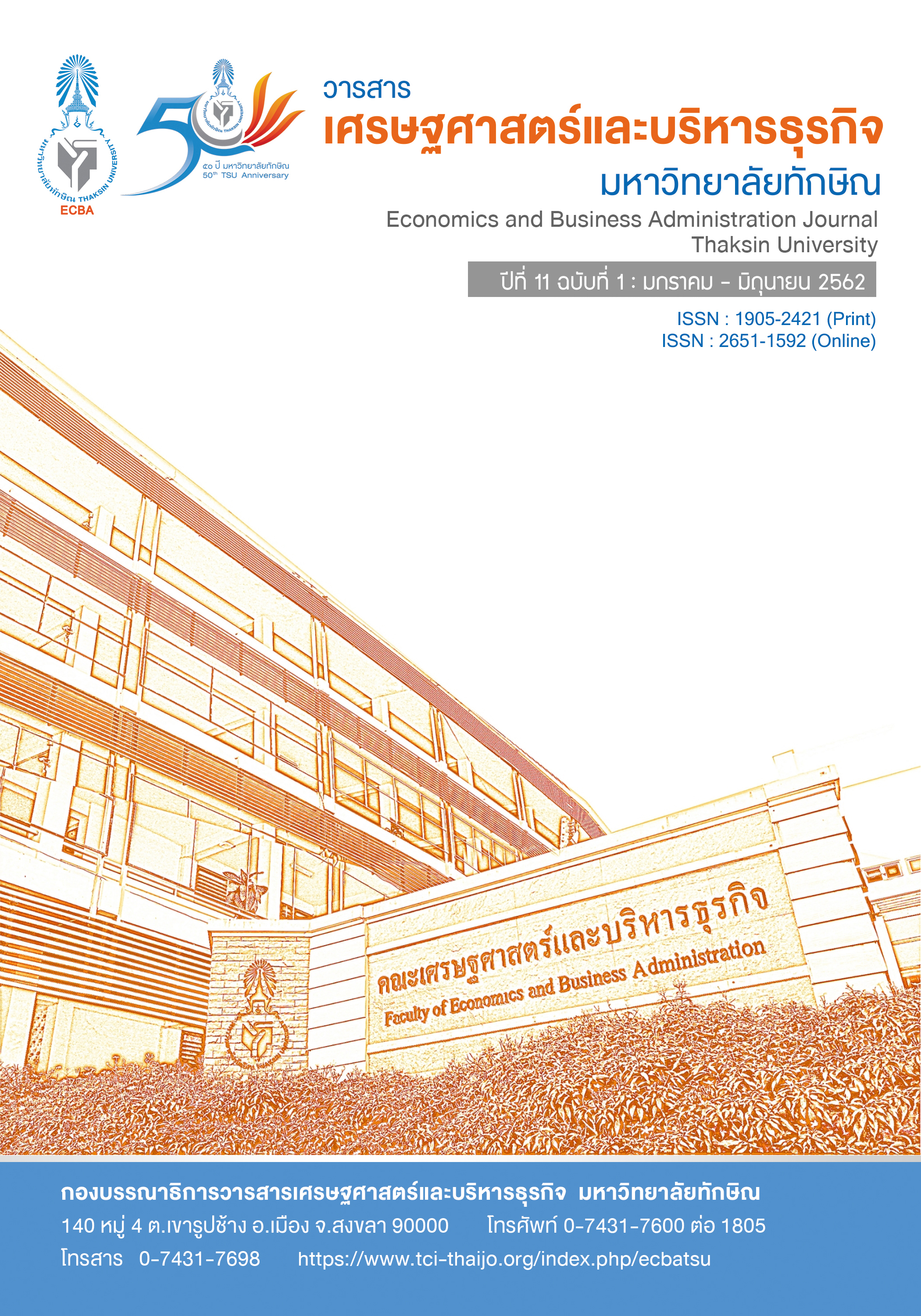Effects of Technology Acceptance and Service Quality on Customer Loyalty for Electronic Banking
Keywords:
Technology Acceptance, Electronic Services Quality, LoyaltyAbstract
This research aims to study 1) the effects of technology acceptance on customer loyalty for electronic banking 2) the effects of electronic services quality on customer loyalty for electronic banking. The sample size was 400 customers in Thailand who used to use electronic banking services. The research instrument was questionnaire. Statistics used for data analysis were frequency, percentage, mean, standard deviation and multiple regression analysis.
Research results revealed that 1) technology acceptance including effort expectancy, facilitating conditions, hedonic motivation, price value and habit dimensions have positive relationship with overall customer loyalty. with the significant statistic level at 0.05 whereas, performance expectancy and social influence dimensions have no relationship with overall customer loyalty. The predictive power was at 65.40 percent. 2) electronic services quality including efficiency, system availability, fulfillment and privacy have positive relationship with overall customer loyalty. with the significant statistic level at 0.05. The predictive power was at 67.20 percent. The commercial bank executives must create technology acceptance and improve electronic service quality to meet the demand and create users trust; which will result in customer loyalty of electronic banking.
References
ชวิศา พุ่มดนตรี. (2559). ปัจจัยที่ส่งผลต่อการยอมรับการใช้บริการพร้อมเพย์ (Promptpay) ของประชาชนในเขตกรุงเทพมหานครและปริมณฑล. การค้นคว้าอิสระ บริหารธุรกิจมหาบัณฑิต. กรุงเทพฯ : มหาวิทยาลัยธรรมศาสตร์.
ธนาคารแห่งประเทศไทย. (2561). ธุรกรรมการชำระเงินผ่านบริการ Mobile banking และ Internet banking. กรุงเทพฯ : ธนาคารแห่งประเทศไทย.
นันทมน ไชยโคตร. (2557). ภาพลักษณ์องค์กรและคุณภาพการให้บริการที่ส่งผลต่อความจงรักภักดีของลูกค้าธนาคารออมสินในเขตบางแค. วิทยานิพนธ์ ศิลปศาสตรมหาบัณฑิต. นครปฐม : มหาวิทยาลัยศิลปากร.
ปิยพงศ์ พู่วณิชย์. (2556). อิทธิพลของการดูแลกำกับกิจการที่ดีและการรับรู้คุณภาพการบริการของลูกค้าที่มีผลต่อความไว้วางใจและความจงรักภักดีของลูกค้าธนาคารออมสิน. วิทยานิพนธ์ บริหารธุรกิจมหาบัณฑิต. นครปฐม : มหาวิทยาลัยศิลปากร.
พรชนก พลาบูลย์. (2558). การยอมรับนวัตกรรมและเทคโนโลยี การใช้เทคโนโลยี และพฤติกรรมผู้บริโภคที่ส่งผลต่อความตั้งใจของประชาชนในการใช้บริการธุรกรรมทางการเงินผ่านระบบพร้อมเพย์ (Prompt Pay) ของรัฐบาลไทย. การค้นคว้าอิสระ บริหารธุรกิจมหาบัณฑิต. กรุงเทพฯ : มหาวิทยาลัยกรุงเทพ.
อุษา แสงแจ่ม. (2557). การใช้ปัจจัยส่วนประสมทางการตลาดในการตัดสินใจเลือกซื้อเครื่องสำอางของผู้บริโภคในเขตปทุมวัน. วิทยานิพนธ์ บริหารธุรกิจมหาบัณฑิต. กรุงเทพฯ : มหาวิทยาลัยเกริก.
Aaker, D. A. (1991). Mamaging Brand Equity : Capitalizing on the Value of a Brand Name. New York : Free Press.
Caro, E. M., Carrion, G., C. and Navarro, J. G. C. (2013). Applying a Technology Acceptance Model to Test Business e-Loyalty Towards Online Banking Transactions. Journal of Business and Information. 8, 404 .
Faruq, M. A. (2016). The Moderating Effect of Technology Awareness on the Relationship between UTAUT Constructs and Behavioral Intention to Use Technology. Australian Journal of Business and Management Research. 3, 14- 23.
Gronroos, C. (1990). “Relationship Approach to Marketing in Service Contexts : The Marketing and Organizational Behavior Interface.” Journal of Business Research. 2(1), 53.
Jansorn, T. (2015). Study of Acceptance Factors for Electronic Payment Services.
ISS & MLB Journal. 452 - 461.
Jukka, O. (2010). “E-Service Quality: A Conceptual Model.” International Journal of Arts and Sciences. 3(7), 127 - 143.
Li, Z. and Wonglorsaichon, P. (2016). The Effect of Perceived Value, Technology Acceptance, and E-service Quality on Customer Satisfaction and Service Loyalty for Instant Message Providers Business. School of Business. UTCC Intenational Journal Business and Economics University of the Thai Chamber of Commerce. 19(2), 139 - 157.
Parasuraman, A., Zeithaml, V.A. and Malhotra, A. (2005). E-S-Qual : A Multiple-ltem Scale for Assessing Electronic Service Quality. Journal of Service Research. 7, 1 - 21.
Rogers, E. M. (2003). Diffusion of Innovation (5th ed.). New York : Free Press.
Venkatesh, V., Thong, J. Y. L. and Xu, X. (2012). Consumer Acceptance and Use of Information Technology : Extending the Unified Theory of Acceptance and Use of Technology. MIS Quartery. 36(1), 157 - 178.
Wu, K. W. (2011). Customer Loyalty Explained by Electronic Recovery Service Quality : Implications of the Customer Relationship Re-establishment for Consumer Electronics E-Tailers. Contemporary Management Research. 7(1), 21 - 44.
Yang, H. E. and Tsai, F. S. (2007). General E-S-QUAL Scales Applied to Websites Satisfaction and Loyalty Model. Communications of the IIMA. 7(2), 115 - 126.




